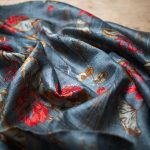When working with fabric, finding the finest transfer paper is crucial for achieving flawless results.
Different types of transfer papers cater to specific fabric types, ensuring optimal adhesion and durability.
Inkjet transfer paper is ideal for cotton fabric, while laser transfer paper excels with polyester.
Sublimation transfer paper is best suited for blended fabrics, and heat transfer paper is perfect for dark fabrics.
For lighter fabrics, printable iron-on transfer paper is the go-to choice.
Eco-solvent transfer paper is recommended for stretchy fabrics, while waterslide decal paper is the top pick for textured fabrics.
Understanding the nuances of each transfer paper type empowers you to masterfully personalize your fabric creations.
Key Takeaways
- Inkjet Transfer Paper is best for cotton fabric, while Laser Transfer Paper is suitable for polyester fabric.
- Sublimation Transfer Paper is ideal for blended fabrics, but compatibility and color vibrancy should be tested.
- Heat Transfer Paper is designed for dark fabrics and requires proper heat press techniques.
- Printable Iron-On Transfer Paper is recommended for light fabrics and requires careful application with an iron.
Inkjet Transfer Paper for Cotton Fabric
When using inkjet transfer paper for cotton fabric, you should carefully follow the instructions for optimal results. Start by ensuring that the inkjet transfer paper is compatible with your specific inkjet printer. Different printers may require different types of ink or settings to achieve the best results.
Proper fabric preparation is crucial for a successful transfer. Make sure the cotton fabric is clean, dry, and free of any wrinkles before you begin the transfer process.
Image quality and durability are also important factors to consider when using inkjet transfer paper for cotton fabric. To achieve the best image quality, ensure that the image you're transferring onto the fabric is high-resolution and suitable for the size of the transfer. This will help prevent any loss of clarity or detail during the transfer process.
Moreover, to enhance the durability of the transfer, consider pre-washing the fabric to remove any sizing and allow the transfer to better adhere to the fabric fibers.
Laser Transfer Paper for Polyester Fabric
To achieve optimal results with laser transfer paper for polyester fabric, it's important to consider printer compatibility and fabric preparation, just as with inkjet transfer paper for cotton fabric.
When using laser transfer paper for polyester fabric, the following points are crucial for successful outcomes:
- Printer Compatibility: Ensure that the laser transfer paper is suitable for use with your specific laser printer model. Some transfer papers are designed for use with certain types of printers, so checking compatibility is essential to avoid potential issues such as paper jams or ink smudging.
- Use Transfer Paper Specifically Designed for Laser Printers: Choose transfer paper that's explicitly intended for laser printers to ensure compatibility and prevent any adverse effects on the printing process.
- Fabric Preparation: Polyester fabric requires specific printing techniques for the best results. Before printing onto polyester fabric using laser transfer paper, it's essential to prepare the fabric appropriately to ensure the design adheres effectively.
- Pre-Press the Fabric: Use a heat press to pre-press the polyester fabric before printing to remove any wrinkles and moisture, ensuring a smooth surface for the transfer process.
Sublimation Transfer Paper for Blended Fabrics
For optimal results with sublimation transfer paper for blended fabrics, ensure that the paper is compatible with your printer and follow proper fabric preparation techniques. When using sublimation transfer paper for blended fabrics, it's crucial to consider the compatibility of the paper with your printer. Additionally, proper fabric preparation, such as pre-pressing the fabric to remove wrinkles and moisture, is essential to ensure the best transfer results.
| Factors | Description |
|---|---|
| Blended Fabric Compatibility | Ensure that the sublimation transfer paper is suitable for the specific blend of fabrics you are using. Different blends may require different types of sublimation paper for optimal results. |
| Color Vibrancy Limitations | Blended fabrics may have limitations in color vibrancy when using sublimation transfer paper. The color reproduction may vary compared to 100% polyester fabrics, so it's important to test the paper with your specific fabric blend to determine the achievable color vibrancy. |
| Printer Compatibility | Check if the sublimation transfer paper is compatible with your specific printer model. Some papers may perform better with certain printer types, so it's important to ensure compatibility for optimal results. |
Understanding the compatibility of sublimation transfer paper with blended fabrics and being aware of potential color vibrancy limitations is crucial in achieving the best results. Always conduct thorough testing to determine the ideal settings for your specific fabric blend and sublimation transfer paper combination.
Heat Transfer Paper for Dark Fabrics
Using the right heat transfer paper for dark fabrics can significantly impact the final appearance and durability of your designs. When working with dark fabrics, it's crucial to choose heat transfer paper specifically designed for use on dark garments to ensure vibrant and long-lasting results.
Here are some essential considerations to keep in mind:
- Heat Press Techniques:
- Use a high-quality heat press machine with even heat distribution to ensure that the transfer adheres uniformly to the fabric.
- Follow the manufacturer's guidelines for temperature, pressure, and press time to achieve the best results for dark fabrics.
- Fabric Preparation Tips:
- Pre-press the dark fabric to remove any moisture and wrinkles before applying the transfer paper.
- Consider using a fabric conditioner or softener to reduce the stiffness of the dark fabric, which can impact the transfer process.
Printable Iron-On Transfer Paper for Light Fabrics
When working with light fabrics, selecting the appropriate printable iron-on transfer paper is essential for achieving vibrant and long-lasting designs. It's crucial to choose transfer paper specifically designed for light fabrics to ensure the best results. Look for transfer paper that's compatible with light-colored fabrics and is designed for inkjet or laser printers, depending on your printer type.
Before printing, ensure that the design is flipped horizontally to avoid any mirror-image issues when transferring onto the fabric.
When it comes to application, follow the manufacturer's guidelines for heat settings and ironing techniques. Typically, you'll need to preheat the iron to the recommended temperature and ensure the fabric is clean and wrinkle-free before applying the transfer.
Place the printed transfer onto the fabric with the image side down and apply even pressure with the iron, moving it in a slow and steady motion. Be sure to pay extra attention to the edges of the transfer to prevent peeling or lifting.
Eco-Solvent Transfer Paper for Stretchy Fabrics
To achieve optimal results when working with stretchy fabrics, it's important to consider the compatibility of eco-solvent transfer paper for your printing needs. Additionally, be sure to select a paper that aligns with the specific requirements of your printer to ensure successful and durable designs.
- Fabric Compatibility and Eco-Solvent Transfer Paper
When working with stretchy fabrics such as spandex or lycra, it's crucial to choose an eco-solvent transfer paper specifically designed for use on these materials. Look for a paper that offers excellent adhesion to stretchy fabrics, preventing cracking or peeling of the transferred design.
- Stretchy Fabric Application and Eco-Solvent Transfer Paper
Eco-solvent transfer paper is well-suited for stretchy fabrics due to its ability to maintain flexibility and stretch along with the fabric. This ensures that the transferred design moves with the fabric without compromising its integrity, making it ideal for activewear, swimwear, and other stretchy garment applications.
When using eco-solvent transfer paper for stretchy fabrics, ensure that the paper is compatible with your printer and that the inks used provide vibrant and long-lasting results on these materials.
Waterslide Decal Paper for Textured Fabrics
When working with textured fabrics, it's important to consider the compatibility of waterslide decal paper. This type of transfer paper may require special attention when it comes to printing and application.
Understanding the specific tips and techniques for achieving optimal results on textured fabrics can make a significant difference in the final outcome of your transfer project.
Textured Fabric Compatibility
If you want to transfer designs onto textured fabrics, using waterslide decal paper may provide the best compatibility. When considering textured fabric compatibility, it's essential to take into account the fabric surface preparation and the specific considerations for textured fabrics.
Here's a deeper look at these two important factors:
- Fabric Surface Preparation
- Ensure the fabric is clean, dry, and free from any wrinkles or creases before applying the waterslide decal paper.
- Consider using a fabric primer or sealer to create a smoother surface for the decal transfer, especially on heavily textured fabrics.
Printing and Application Tips
For best results when using waterslide decal paper on textured fabrics, follow these printing and application tips.
Begin by ensuring that your fabric is appropriately prepared. Textured fabrics may require additional steps such as pre-treating with a fabric primer to create a smooth surface for the decal to adhere to.
When it comes to printing techniques, ensure that your printer settings are adjusted for the best quality print. Use the highest print resolution available to achieve sharp and vibrant images. Additionally, consider performing a test print on a regular piece of paper before using the waterslide decal paper to ensure the colors and details come out as desired.
Following these fabric preparation and printing tips will help you achieve the best results when using waterslide decal paper on textured fabrics.
Frequently Asked Questions
Can Transfer Paper Be Used on Fabrics With a High Polyester Content?
Yes, transfer paper can be used on fabrics with a high polyester content. When using transfer paper on high polyester fabrics, it's important to choose the best transfer paper for textured surfaces to ensure a successful transfer.
What Is the Best Transfer Paper for Fabrics With a Textured Surface?
For textured fabrics, the best transfer paper is one designed specifically for use on textured surfaces. Look for transfer paper that is compatible with polyester fabrics and has a strong adhesive for a durable transfer.
Are There Any Transfer Papers That Work Well on Stretchy Fabrics Like Spandex or Lycra?
For stretchy fabrics like spandex or lycra, it's essential to choose transfer paper that is compatible with the material's properties. Look for transfer papers specifically designed for stretchy fabrics to ensure optimal adhesion and durability.
Can Transfer Paper Be Used to Create Designs on Dark-Colored Fabrics?
Yes, transfer paper can be used to create designs on dark-colored fabrics. However, there are limitations as the colors may not appear as vibrant. Consider the polyester content as transfer paper is less effective on high polyester fabrics.
Is There a Specific Type of Transfer Paper That Is Best for Blending Images Into the Fabric for a Seamless Look?
When blending images into fabric, consider transfer paper designed for fabric compatibility. Look for papers that offer seamless blending techniques for a professional, polished look. Experiment with different brands to find the best fit for your project.
- Tetron Fabric for Marine Applications: Durability and Use Cases - June 18, 2025
- Tetron Fabric for Outdoor Furniture: Weather Resistance and Care - June 18, 2025
- Tetron Fabric for Wall Coverings: Style and Application Tips - June 18, 2025






